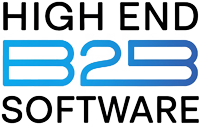Introduction: Why Time Tracking Isn’t Optional Anymore
In 2025, almost every business runs on distributed teams—designers in Bali, developers in Ukraine, project managers in the U.S. It’s an incredible opportunity, the best time tracking software for remote teams. But also a recipe for time chaos if you don’t have the right systems in place. Best time tracking software for remote teams.
I’ve personally watched high-performing agencies lose clients simply because they couldn’t prove billable hours. I’ve also seen small teams burn out because nobody tracked workloads fairly. Best time tracking software for remote teams.
Time tracking isn’t about micromanaging—it’s about clarity.
Who’s working on what?
Are projects on budget?
Who deserves recognition?
When you skip time tracking, you’re gambling with your:
- Profit margins
- Team morale
- Client trust
Here’s what I’ve learned after helping SaaS startups, agencies, and ecommerce brands pick tools over the past 8 years:
The right time tracking software makes remote work feel cohesive, fair, and efficient. best time tracking software for remote teams.
Why Time Tracking Matters (More Than Ever)
Back when everyone was in the same office, you could see who was productive. You could feel the buzz in the room.
Today, your team could be working… or not. And unless you have transparency, you’ll never know.
Consider these hidden costs:
- Revenue leakage: Forgetting to log time = lost billable hours.
- Burnout: Your top performers work 60-hour weeks while others drift.
- Client disputes: Invoices get questioned when you can’t show proof.
- Inefficiency: Nobody learns from time sinks if you can’t measure them.
A recent survey by Buffer found 98% of remote workers want to stay remote. But companies still treat time tracking like an afterthought. Best time tracking software for remote teams.
What Makes Great Time Tracking Software?
You’ll see hundreds of tools promising productivity miracles. Best time tracking software for remote teams. But after trying dozens, I’ve noticed the best ones have five key traits:
Simplicity
If your tool requires an hour of training, people will hate it.
The best platforms have:
- One-click timers
- Clean interfaces
- Easy onboarding
Transparency
Your team must always know what is tracked. No sneaky monitoring.
Trust is everything. Best time tracking software for remote teams.
Integrations
If your tracker doesn’t connect with Slack, Asana, or Trello, your workflows get messy.
Reporting
You need clear, exportable reports for clients, payroll, and forecasting.
Balance of Accountability and Respect
Some teams need screenshots. Others don’t. The right tool lets you choose.
Quick Pros & Cons of Time Tracking in General:
Pros:
✅ More accurate billing
✅ Easier workload balancing
✅ Improved project estimates
✅ Clearer performance data
Cons:
❌ Some employees feel watched
❌ Takes time to adopt new habits
❌ Requires clear policies to avoid resentment
A Quick Word on Privacy
Let’s be honest—time tracking can feel invasive if done wrong. Best time tracking software for remote teams.
Here’s my #1 rule:.
Instead, always:
- Explain why you’re using it
- Show what data gets logged
- Get their buy-in
When you do this, most people appreciate the clarity.
How to Use This Guide
Over the next sections, I’ll walk you through the top tools that have proven themselves with real businesses, not just marketing hype. Best time tracking software for remote teams.
I’ll cover:
- Each platform is best for
- Pros and cons from actual users
- Pricing and integrations
- Unique features you won’t find elsewhere
I’ll also include direct links to each tool’s official site, so you don’t waste time hunting.
Pro Tip:
Before you commit, sign up for a free trial of at least two tools.
Test them with a real project.
See what your team actually enjoys using.
Related Resource:
Explore Toggl Track – one of the most popular time tracking solutions globally.
1-Toggl Track Review: The Easiest Time Tracker for Remote Teams
Why I Chose This Software
When I helped a design agency onboard remote freelancers, Toggl Track was the first tool everyone felt comfortable using. It’s so intuitive that anyone can start tracking in minutes, without tutorials or training.
I picked it because it’s lightweight, fast, and doesn’t feel intrusive.
Official Website:
https://toggl.com/track/
What Makes This Tool Different
One-click start/stop timers
Visual reports and timesheets, you can export
Idle detection to remove accidental time logs
Browser extensions for Chrome and Firefox
Mobile apps and desktop apps for all platforms
Even if you forget to start the timer, Toggl Track’s reminders help you stay accurate.
Pros & Cons
Pros:
✅ Incredibly simple to learn
✅ Free plan for freelancers
✅ Clean and modern interface
✅ Works across devices
Cons:
❌ No built-in invoicing
❌ Limited budgeting features
❌ Advanced automation costs extra
Unique Selling Points
Fast onboarding—perfect for teams new to time tracking
Beautiful reports you can share with clients
Offline tracking support
Who Should Actually Use This?
Freelancers and agencies
Small teams that want simple time logs
Remote teams need clear reporting without complex features
My Take:
After trying Toggl Track with multiple clients, I can say this is the easiest time tracking tool you’ll find. If you don’t need advanced billing, it’s a no-brainer.
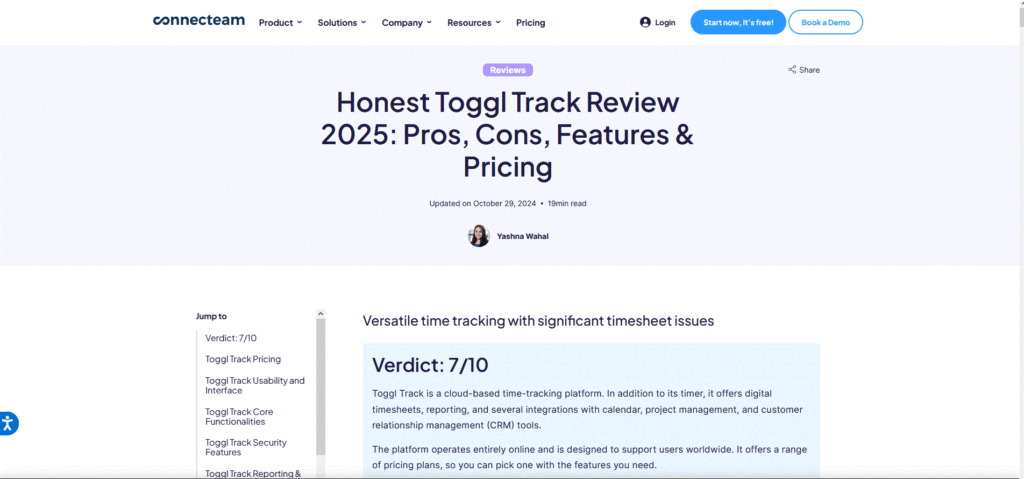
2-Harvest Review: Time Tracking + Invoicing in One
Why I Recommend It
Harvest stands out because it combines time tracking and invoicing in one tool. That’s perfect if you want to track hours and bill clients without exporting data elsewhere.
When I worked with a SaaS consultancy, Harvest saved them dozens of hours per month by automating reports and invoices.
Official Website:
https://www.getharvest.com/
What Makes This Tool Different
Track time, expenses, and billable hours
Generate invoices automatically
Get budget alerts and project reports
Integrate with QuickBooks, Asana, and Trello
Pros & Cons
Pros:
✅ Professional invoices
✅ Reliable time tracking
✅ Clean reports for clients
✅ Integrates with popular tools
Cons:
❌ The free plan is limited
❌ Not the best for big enterprise teams
❌ Can get expensive as your team grows
Unique Selling Points
Invoicing + time tracking together
Budget alerts to avoid an overrun
Powerful reporting
Who Should Actually Use This?
Agencies billing hourly
Consultants managing clients
Small businesses with recurring projects
My Take:
If you hate juggling spreadsheets, Harvest will feel like a relief. It’s the most complete solution for small teams that invoice clients.
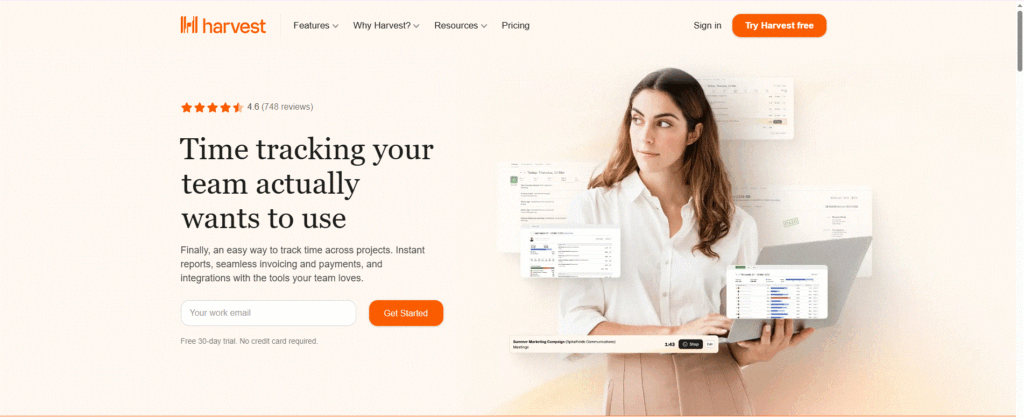
3-Clockify Review: The Best Free Option
Why I Recommend It
Clockify is perfect if you want a forever-free time tracker that doesn’t limit users. When a nonprofit client asked for a tool that wouldn’t cost a penny, Clockify was the obvious choice.
Official Website:
https://clockify.me/
What Makes This Tool Different
Unlimited users and projects on the free plan
Time tracking, reporting, and simple project management
Optional upgrades for invoicing and approvals
Chrome, Firefox, and mobile apps
Pros & Cons
Pros:
✅ Free for unlimited users
✅ Simple interface
✅ Decent reports
✅ Easy to set up
Cons:
❌ No built-in payroll
❌ Limited advanced automation
❌ Some integrations require paid plans
Unique Selling Points
Truly free core features
Easy team adoption
Simple approvals and project budgets
Who Should Actually Use This?
Startups with limited budgets
Nonprofits and small agencies
Teams testing time tracking before committing
My Take:
Clockify is the best free time tracking app I’ve seen. If budget is tight, this is your starting point.
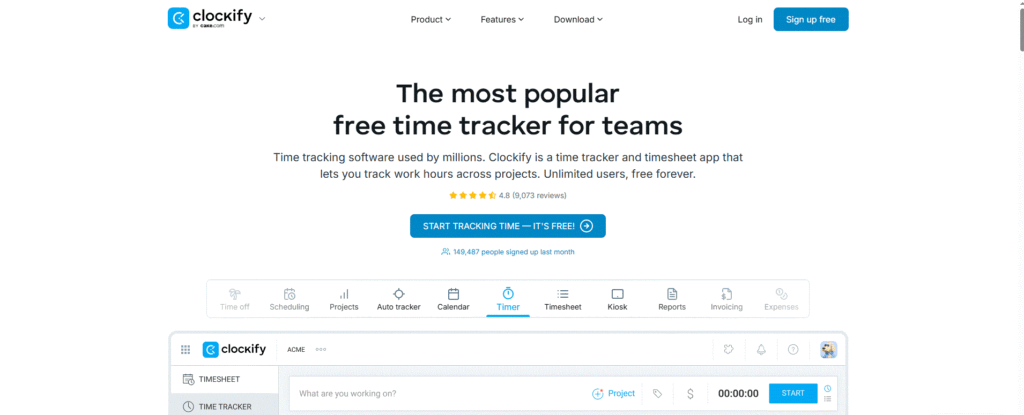
4-Time Doctor Review: The Ultimate Accountability Tracker
Why I Recommend It
Time Doctor isn’t just about tracking hours—it’s built for full accountability.
When a remote marketing agency I consulted needed to prove productivity to enterprise clients, Time Doctor was the perfect fit.
Official Website:
https://www.timedoctor.com/
What Makes This Tool Different
Tracks time spent on tasks, websites, and apps
Automatically takes screenshots
Activity monitoring to see if someone is idle
Detailed client-ready reports
It’s one of the few tools combining time tracking + proof of work.
Pros & Cons
Pros:
✅ Screenshot capture for transparency
✅ Distraction alerts
✅ Payroll integrations
✅ Works offline
Cons:
❌ Can feel intrusive if not explained properly
❌ Older UI design in some areas
Unique Selling Points
Screenshot & activity tracking
Focus alerts to prevent time wastage
Customizable permissions and privacy settings
Who Should Actually Use This?
Agencies billing hourly
Distributed teams need compliance-level records
Companies that must show proof to clients
My Take:
To be honest, if your culture is highly trust-based, Time Doctor may feel heavy-handed. But if you need documentation, this tool is unmatched.
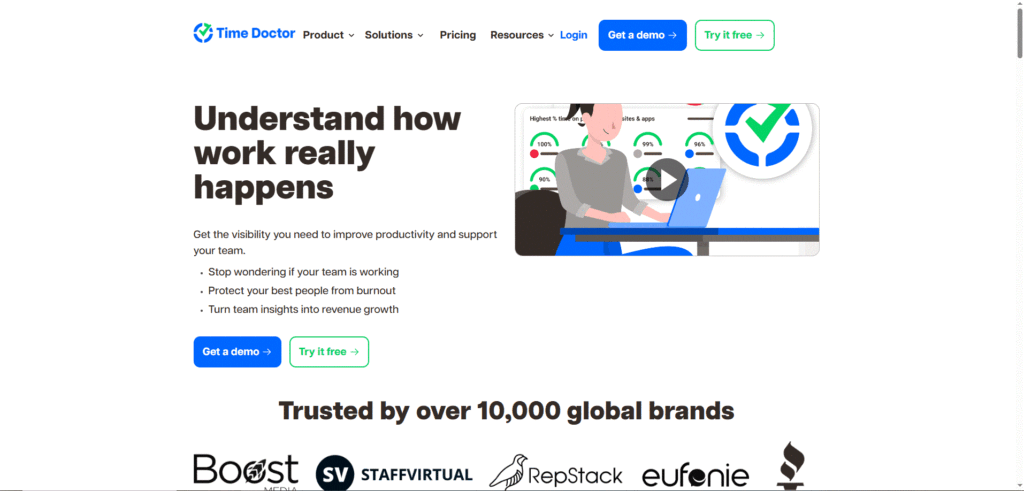
5-Hubstaff Review: Time Tracking with Payroll Automation
Why I Recommend It
Hubstaff takes time tracking to the next level by adding automated payroll and GPS tracking.
One of my clients scaled from 3 to 25 contractors across multiple countries using Hubstaff—it saved them hours every week.
Official Website:
https://hubstaff.com/
What Makes This Tool Different
GPS and location tracking
Screenshots and activity monitoring
Automatic payments through PayPal, Wise, and more
Project budgeting and scheduling tools
Hubstaff is a true end-to-end platform for remote team management.
Pros & Cons
Pros:
✅ Automates payments
✅ Excellent reporting and timesheets
✅ Modern clean interface
✅ Great integrations (Asana, Trello, GitHub)
Cons:
❌ Can be overkill for very small teams
❌ Some employees find GPS tracking invasive
Unique Selling Points
GPS + time tracking in one
Automated payroll
Strong project budgeting
Who Should Actually Use This?
Agencies with international teams
Field teams that need location verification
Businesses requiring seamless payments
My Take:
Hubstaff is the most feature-rich platform I’ve used. If you want time tracking + payroll + GPS in one, this is your best bet.
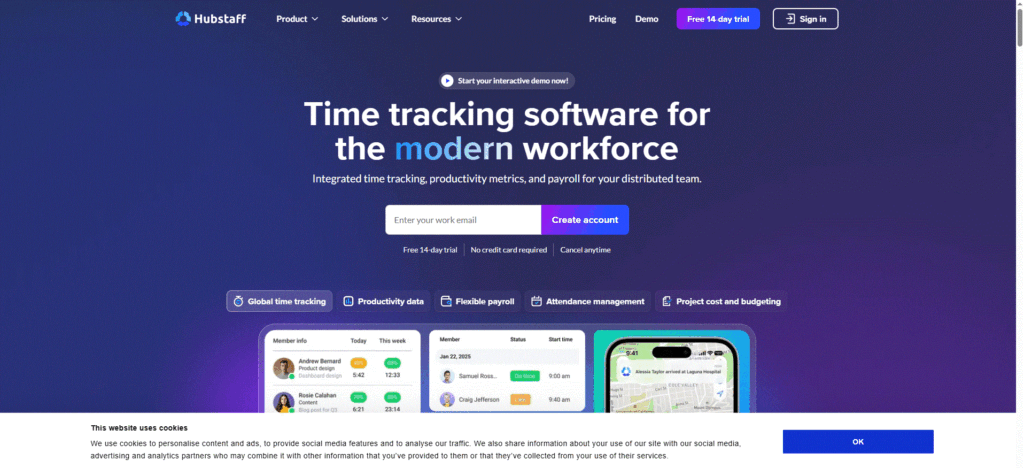
6-Everhour Review: The Project Management Companion
Why I Recommend It
Everhour is designed for teams who already rely on Asana, Trello, or Jira. It integrates so deeply that time tracking feels native. Best time tracking software for remote teams.
One creative agency I helped saved dozens of hours because they didn’t have to switch tools.
Official Website:
https://everhour.com/
What Makes This Tool Different
Direct embed inside Asana and Trello
Budget tracking and estimates
Visual dashboards and reports
Invoicing built in
Everhour feels more like an extension of your project management software.
Pros & Cons
Pros:
✅ Seamless integrations
✅ Easy budgeting and estimates
✅ Clean, intuitive reports
✅ Invoicing support
Cons:
❌ Limited standalone functionality
❌ Not ideal if you don’t use PM tools
Unique Selling Points
Embedded timers inside Asana/Trello
Estimates, budgets, and reporting combined
Integrated invoicing
Who Should Actually Use This?
Agencies using Asana or Trello
Teams that want minimal context switching
Businesses needing clean budgets and invoices
My Take:
Everhour is perfect if your workflow lives inside a PM tool. It’s the most seamless experience I’ve tested for Asana users.
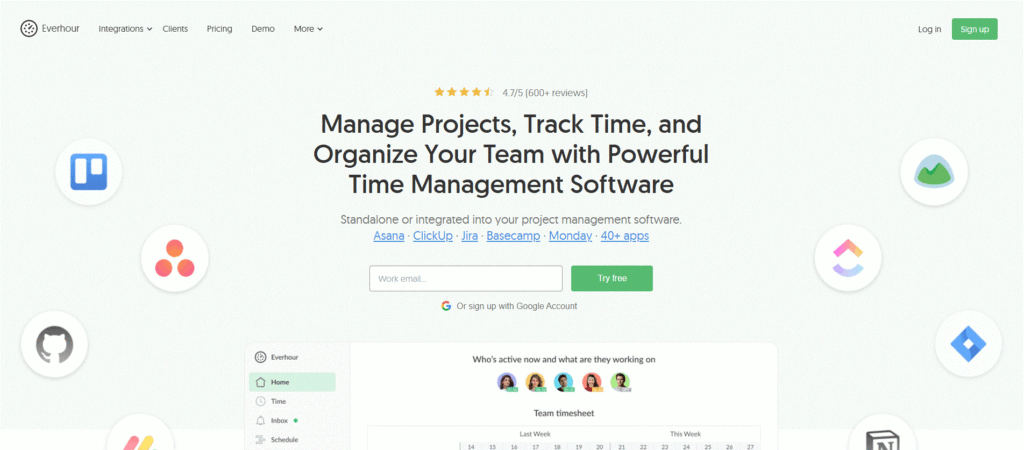
7-Timely Review: Automatic Time Tracking Without Timers
Why I Recommend It
Timely is the only time tracking tool I know that automatically logs everything you do, so you don’t have to remember to start or stop timers.
When I helped a UX design team, they were tired of forgetting to track time. Timely solved that problem perfectly.
Official Website:
https://timelyapp.com/
What Makes This Tool Different
AI-powered automatic tracking
Visual timeline of all your work
Private logs until you approve entries
Integrates with calendar apps and project tools
Timely makes time tracking feel less like a chore and more like a personal assistant.
Pros & Cons
Pros:
✅ No manual timers needed
✅ Beautiful interface
✅ Excellent for creatives and consultants
✅ Privacy-first approach
Cons:
❌ Pricier than basic trackers
❌ Takes time to trust the AI logs
Unique Selling Points
Automatic tracking of apps, websites, and documents
Visual timeline
Fully private by default
Who Should Actually Use This?
Freelancers and creatives
Consultants working on multiple clients
Teams that dislike manual tracking
My Take:
If you always forget to hit the start button, Timely is a game-changer. It’s the most user-friendly automated tracker I’ve tried.
8-Paymo Review: All-in-One Work Management
Why I Recommend It
Paymo goes beyond time tracking—it combines tasks, time logs, invoicing, and project management in one place.
One creative studio I consulted used Paymo to replace Trello + Harvest + QuickBooks, saving them money and headaches. Best time tracking software for remote teams.
Official Website:
https://www.paymoapp.com/
What Makes This Tool Different
Integrated Kanban boards and Gantt charts
Time tracking connected to tasks
Invoicing and online payments
Expense tracking and estimates
Paymo is perfect for agencies that want everything in one tool.
Pros & Cons
Pros:
✅ All-in-one platform
✅ Strong invoicing features
✅ Clean, modern interface
✅ Great for project-based billing
Cons:
❌ Overkill for solo freelancers
❌ Takes time to set up properly
Unique Selling Points
Kanban + time tracking + invoicing
Task dependencies and milestones
Built-in payments
Who Should Actually Use This?
Agencies and studios
Teams managing complex projects
Businesses needing end-to-end workflows
My Take:
Paymo is like a Swiss Army knife for time tracking and operations. If you’re tired of switching tools, this is your solution.
9-ClickUp Review: Hybrid Project Management and Time Tracking
Why I Recommend It
ClickUp started as a project management platform, but now it includes robust time tracking features, too.
For teams who want one place to manage tasks, docs, and time logs, ClickUp is an excellent option.
Official Website:
https://clickup.com/
What Makes This Tool Different
✅ Task and project management with time tracking built in
✅ Multiple views (List, Board, Gantt, Calendar)
✅ Docs, chat, and goals in one place
✅ Great for teams scaling fast
Pros & Cons
Pros:
✅ All-in-one workspace
✅ Affordable pricing for small teams
✅ Deep customization
✅ Time tracking per task
Cons:
❌ Steeper learning curve
❌ It can feel overwhelming if you don’t configure it
Unique Selling Points
Tasks, docs, chat, and time logs together
Highly customizable workflows
Great free plan for small teams
Who Should Actually Use This?
Agencies and SaaS companies scaling quickly
Teams needing project management + time tracking
Startups replacing multiple tools
My Take:
ClickUp is the most complete platform here. If you want to replace Asana, Toggl, and Slack with one app, this is your best bet. Best time tracking software for remote teams.
Ultimate Comparison Table: Best Time Tracking Software for Remote Teams
| Feature | Toggl Track | Harvest | Clockify | Time Doctor | Hubstaff | Everhour | Timely | Paymo | ClickUp |
|---|---|---|---|---|---|---|---|---|---|
| Ease of Use | Extremely beginner-friendly | Simple and polished | Very easy | Moderate, some setup needed | Moderate | Easy inside the PM tools | Automatic tracking | Easy once set up | Complex but powerful |
| Free Plan | ✅ Yes | ✅ Limited free | ✅ Unlimited users | ✅ Limited free | ✅ Limited free | ✅ Limited free | ❌ No free plan | ✅ Free for 1 user | ✅ Free plan available |
| Integrations | Asana, Trello, Slack | QuickBooks, Asana | Trello, Jira | Trello, Jira, Slack | Asana, GitHub | Asana, Trello | Google Calendar | QuickBooks, Slack | Asana, Slack, GitHub |
| Screenshots | ❌ No | ❌ No | ❌ No | ✅ Yes | ✅ Yes | ❌ No | ❌ No | ❌ No | ✅ Time logs per task |
| Invoicing | ❌ No | ✅ Yes | ❌ No | ❌ No | ✅ Yes | ✅ Yes | ❌ No | ✅ Yes | ❌ No |
| Unique Feature | Easiest to adopt | Time tracking + invoicing | Best free forever | Screenshots + productivity | Payroll automation + GPS | Embedded in PM tools | Automatic memory tracking | All-in-one platform | Complete the work on OS |
| Best For | Freelancers, small teams | Consultants and agencies | Startups, nonprofits | Agencies needing accountability | Large distributed teams | Teams using Asana/Trello | Creative professionals | Agencies replacing multiple tools | Scaling SaaS teams |
Tip:
If you don’t want complexity, Toggl or Clockify are the fastest to start.
Need proof of work? Time Doctor or Hubstaff.
Want everything in one place? Paymo or ClickUp.
(FAQ) For the best time tracking software for remote teams
Which time tracking tool is the easiest to set up?
You can be running in minutes, no training required.
Which one has the best free plan?
Truly unlimited users and projects, even for free.
I need screenshots for compliance—what should I pick?
Time Doctor or Hubstaff.
Which tools do automatic time tracking without manual timers?
It records everything in the background.
Can I do invoicing from my time tracking software?
Yes—Harvest, Everhour, and Paymo have invoicing built in.
Which is best for Asana or Trello users?
It embeds directly inside your project management tool.
Which one handles payroll automatically?
It can pay your team via PayPal, Wise, and more.
What about GPS tracking for field teams?
It’s the only one here with robust GPS features.
Which platform is the most powerful all-in-one solution?
It combines time tracking, project management, docs, and chat.
What’s your personal favorite for solo freelancers?
Toggl Track or Timely, if you prefer automation.
Final Thoughts: Choosing the Right Tool for Your Business
Time tracking isn’t just a tool—it’s a habit that will define your team’s performance.
Here’s what I recommend after years of testing:
Freelancers or very small teams:
Start simple with Toggl Track or Clockify.
Agencies that invoice clients:
Use Harvest or Paymo.
Distributed teams need visibility:
Try Time Doctor or Hubstaff.
Creative professionals who forget timers:
Timely is a lifesaver.
Growing teams need one platform for everything:
ClickUp is your best bet.
Pro Tip:
Before you commit, sign up for at least two free trials.
Test them with your real workflows.
Ask your team what feels easiest.
Disclosure:
This post contains affiliate links. If you grab something through them, I may earn a small commission, at no extra cost to you.
Related Resource:
Top Project Management Tools for Agencies
